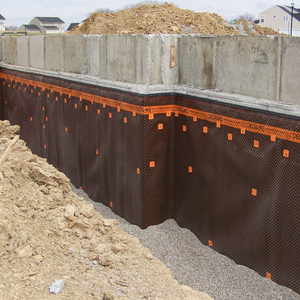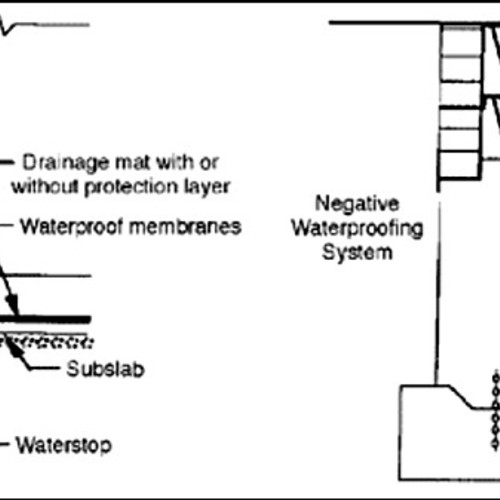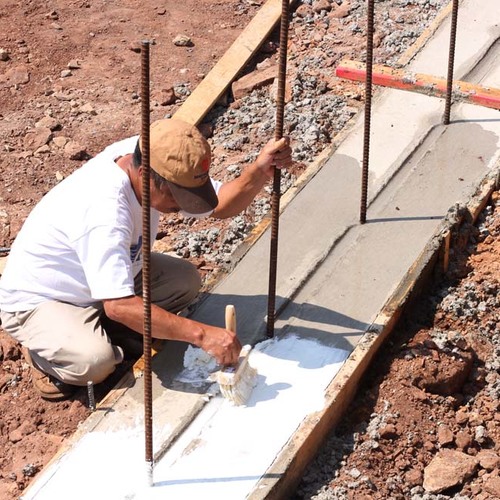
In the first round of Wingut testing of negative side waterproofing, I was pretty focused on how various interior basement waterproofing systems dealt with hydrostatic pressure. But in recent workshops I conducted for a Wisconsin nonprofit called SeventhWave, I have gotten this question just about every time: “OK, so you need the crystalline waterproofing systems to deal with water under pressure. But what about basement walls and floors that see water that is not under pressure?”
That question got me thinking: could I use the same waterproofed concrete block columns and wet them in such a way that water would wick into the concrete by capillarity? This is liquid water that gets pulled into the masonry (concrete, block, brick, etc.) rather than liquid water that is pushed.
This test requires a spray bottle
As water runs down the untreated exterior wall of a foundation, the water gets pulled into untreated, porous masonry by wicking. If enough water is running down the exterior surface, the porous masonry can become saturated all the way to the interior surface.
The test method that I came up with turned out to be pretty simple: Rather than pouring water into the concrete columns, I simply sprayed the top blocks. The sprayed water (applied to the interior of the blocks) is just like water running down the exterior of the basement wall. (See the photo above, and the first image in the gallery.)
Weekly Newsletter
Get building science and energy efficiency advice, plus special offers, in your inbox.
When I sprayed the untreated block column, it took about 10 minutes of continuous spraying before the exterior surface of the top block showed signs of wetting. I then sprayed the column treated with UGL Drylok Extreme (see Image #2 in the Gallery).
You will have to trust me on this: there is no water being expressed on the exterior of the Drylok column. That frankly surprised me, so I continued wetting both columns for an additional 10 minutes: still no wicked water to the exterior of the Drylok column.
The Xypex column gets damp
I then pulled up the two crystalline waterproofed concrete block columns: the one treated with Xypex Concentrate and the one treated with Koster NB1 Grey. Repeating the spraying process, I got another surprise: the top block of the Xypex column showed wetting while the Koster column did not (see Images #3 and #4).
To be absolutely sure of these results, I repeated the spray water test for each column a week after the first test: the results were the same. The Drylok and Koster columns did not show any signs of wetting on the exterior, but both the untreated column and the Xypex column did show signs of wetting (see Images #5 and #6).
Interpret these results with caution
Conclusion? You know my caveats about this sort of “wingnut” testing: these are anecdotal reports; you should do your own testing using the materials in your basements: brick, block, or cast concrete. But my testing shows that while Drylok did not stop water under hydrostatic pressure, it did stop water from wicking past the waterproofing. Conversely, Xypex did stop water under hydrostatic pressure but not from wicking. Only the Koster waterproofing system resisted both hydrostatic pressure and wicking.
The only explanation I have for these results is that the priming and bonding emulsion elements of the Koster system — ones that I was specifically directed by Koster to apply to deal with the concrete block composition — are essential for full waterproofing results in CMU assemblies.
And these results suggest that if you are sure that your below-grade assemblies will never see hydrostatic pressure, maybe the non-crystalline Drylok will work. But remember: none of these systems are self-healing for future cracks, so the need to inspect (and possibly repair) these negative side waterproofing systems holds.
Note: The best way I can think of to improve on wingnut testing is for you to do testing of your own, and work with product manufacturers to explain the results and improve our real-world testing.
_______________________________________________________________________
Peter Yost is a founding member of Green Building Advisor and principal of Building-Wright.















2 Comments
Hi,
Can the Koster and/or Xypex be used for an existing basement floor as well? And, are there any experienced installers/contractors for either product near Stamford, CT?
Thanks
Andy
7061227,
Do you have any form of insulation or membrane barrier under your slab? Also, is the slab placed over a washed rock base to break capillary action from ground water. If not, then Xypex may not perform the way you want. I am not sure any coating will except perhaps epoxy floor paint. If the floor is damp already, attempting to seal it with a paint is fraught with peril. If your slab is direct to soil then you will be forever battling ground moisture/water peculiar to your circumstances. First ensuring that water is not being fed under the slab from poor exterior drainage might be a better first plan.
FWIW, I put Xypex additive in all the concrete loads for footings and walls to control for a known seasonal ground water condition due to being on sandstone bedrock. Despite a full perimeter exterior footing drain, I know that I have as much as 12" of water buildup at the low point of my sloping foundation's interior perimeter during spring run off. The washed rock under the foam and plastic barrier is deep enough for radon pipes and in places is over 2' deep, so I don't worry about contact with foam or plastic. Just the same, the Xypex does not seem to be allowing any significant upward migration of moisture either via the footing to wall joint or the wall directly when the tide is in.
The Xypex rep (8 yrs ago) cautioned me that the crack spanning properties of the additive were meant to prevent bulk water. The crystals apparently grow as needed in the presence of water. If I recall correctly, the concrete would remain "vapor open" so to speak. I have not found that to be a worry and I have my sheet goods and other lumber stored directly against the walls with no ill effect. Humidity in the basement is higher than upstairs largely due to being much cooler.
The relevant point for you is that Xypex on a soggy slab might prevent bulk water from appearing and even retard a fair percentage of water transmission, but trying to cap the slab with flooring or paints will likely cause moisture build up. Removing the evaporation escape valve for the slab means it will only get soggier.
Log in or create an account to post a comment.
Sign up Log in